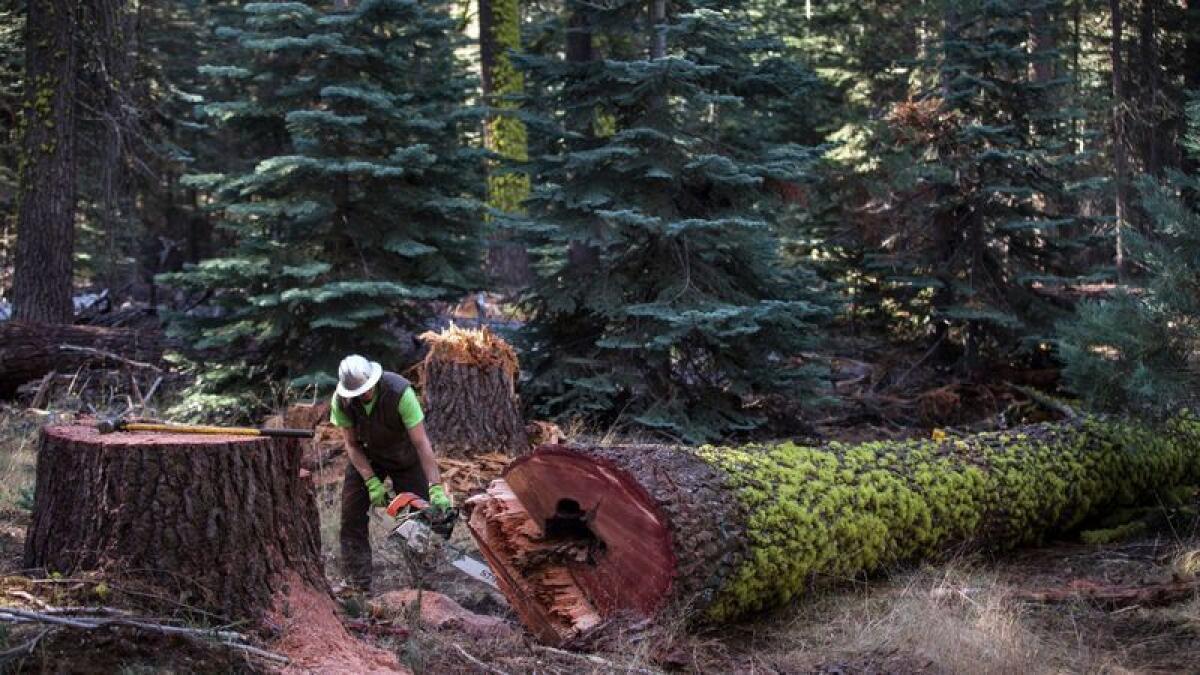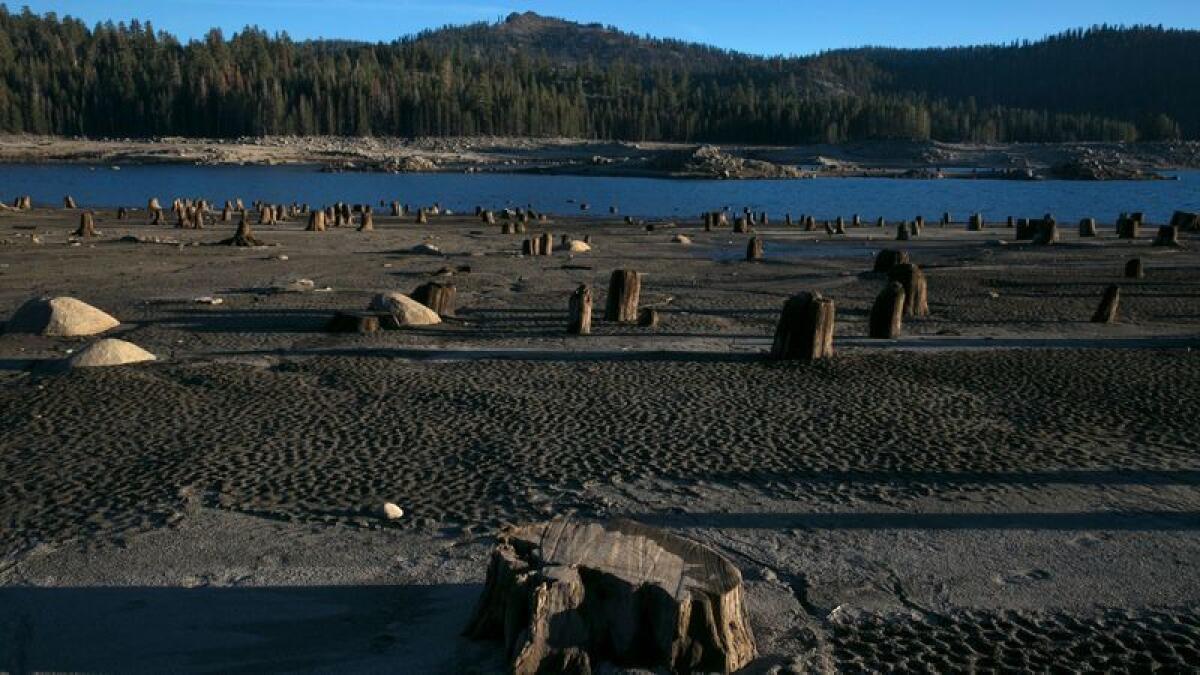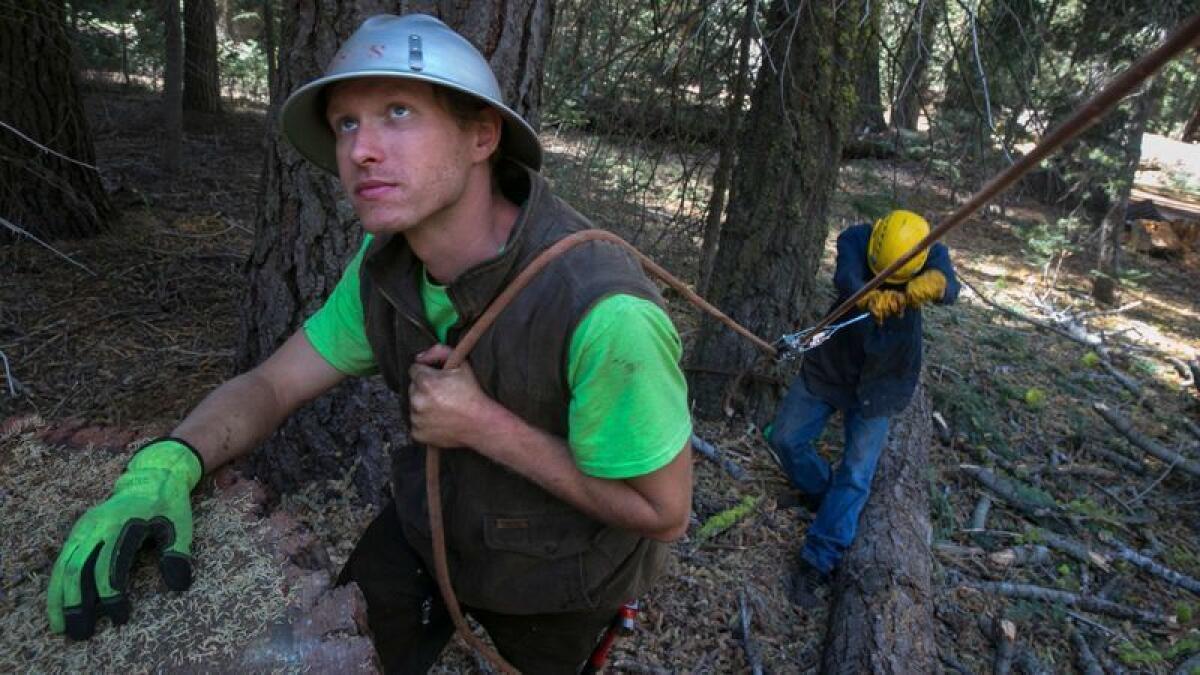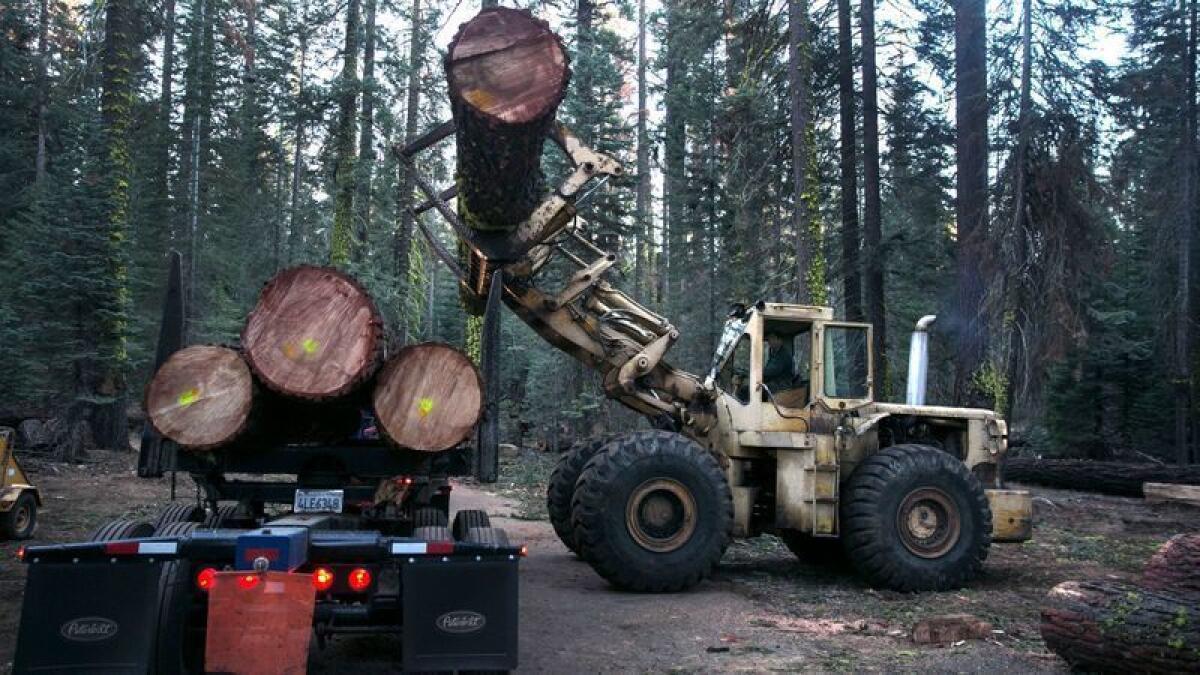The 102 million dead trees in California’s forests are turning tree cutters into millionaires

Getting rid of the massive amounts of dead trees in California has become both a problem and an opportunity.
- Share via
Reporting from LAKESHORE, CALIF. — A low gargle echoes against granite cliffs and resounds in the wooded canyons.
Each pull of a starter handle and squeeze of a throttle is punctuated by the crack of splintering wood as another dead tree falls in a forest that’s changing all too rapidly.
Niles Kant stands at the base of a red fir. Its crown, a thatch of brown needles, rises nearly 175 feet above a collection of cabins in the national forest.
The fir, partially cut at its base and tethered to a rope that will direct its fall, is one of nearly 20 trees that Kant and his crew will drop today, a volume that can never keep pace with the need.
Estimates by the U.S. Forest Service put the number of dead trees in California forests at 102 million, broad swaths that officials call a wildfire and public safety risk. Declaring a state of emergency last fall when the count stood at 40 million, Gov. Jerry Brown ordered state agencies to clear the hazards.

The die-off has hit the southern half of the Sierra Nevada range — Fresno and Tulare counties — especially hard. The Forest Service estimates more than 24 million trees in this region are dead, and getting rid of them has become both a problem and an opportunity.
“There is a Gold Rush for those of us who are willing to bust ass,” says Kant, who charges $1,700 a day for his services.
Kant, 49, owns the Huntington Lake Tree Service, one of more than two dozen outfits working along California 168 that begins just east of Fresno and ends at Huntington Lake, elevation 7,000 feet.
Since first arriving in these mountains in 1997 — and starting a firewood company 15 years ago — Kant has watched as drought, beetle infestation and warming temperatures, all symptoms of climate change, have transformed the mountains he loves.
“I used to think that nothing could affect us in the forest, but between the fires and the drought, the forest is hurting,” he says.

Today, he and his crews are rushing to beat the approach of winter when storms and snowfall shut down the higher elevations and the income that this disaster has delivered to them, one tree at a time.
The fir’s crown starts to tremble, and the back cut grows wider. Kant steps away. His son, Brock, kills the saw. The guide rope is cinched tight, and Garrett McGee delivers one final shot, his sledgehammer clinking against the wedge.
A terrible groaning from the stretching and tearing of wood fibers fills the campground.
Picking up speed, the fir crashes through the surrounding canopy. Severing its limbs and those of neighboring trees, it lands with the force of a 10-ton truck hitting a wall at 90 miles per hour, an explosion gauged to be the equivalent of four pounds of TNT.
The impact kicks up a gust of wind. Branches, bark and duff fly. The surrounding mountains capture the echo. Then there is silence.
“Beautiful, Bubba,” Kant shouts to his son.
::
This October morning, with temperatures rising from a low of 28, Kant is running three crews on the north side of the lake. His occasional partner Craig Erickson is helping.
Erickson, 40, drove in the previous night from his home and business — Koala Tree Care — in the Santa Cruz area to help bring down a 700-year-old Ponderosa pine, located in a nearby condominium development.
What takes hundreds of years to grow can be brought down in less than five minutes with a chainsaw, a sledgehammer and a couple of wedges. But the Creepy Tree — so named by the children of the neighborhood with their Harry Potter imaginations — will take two days.
Growing on a hillside in a sunlit glade, the pine is nearly 200 feet tall, 7 feet across at the base, its bark richly furrowed. Each branch, angling skyward, could be its own tree and just as doomed as the others in the forest, their limbs clothed with shocks of brown needles.
With spurs on his boots and a rope lasso, Erickson shimmies up a smaller adjacent tree before swinging over to one of the Creepy Tree’s branches. He moves with the ease and confidence that 20 years of climbing trees have given him.
“Caleb, can you check the air filter and make sure it’s clean?” he shouts to the ground crew that prepares his chainsaws for him.

Kant employs mostly young men in their 20s, who started working straight out of high school. Union work was too unpredictable, trade school to expensive. They are drawn to the excitement and danger of the job — and the pay ($14 to $20 an hour based on experience).
He and Erickson met at the local bar. Erickson, whose family has been coming to these mountains since 1915, was nursing an iced tea — anything stronger is incompatible with the demands of the job — and Kant needed advice on a tree growing near the deck of a house. Many years later, they’re still teaming up on difficult jobs.
Kant explains their strategy: “We’re going to take the branches off, blow the top down in sections, and when it’s short enough, we’ll drop the stick in that direction.”
He points east, a neat trick given the tree’s southerly tilt toward a few aspens, cherished by the property owner, and the living rooms and kitchens, valued by the next-door neighbors.
Overhead, the chainsaw pops — it’s a 460 with a 32-inch bar — and blond shavings, lit by the sun through a haze of exhaust fumes, surround Erickson. Soon a branch almost 3 feet across crashes to the ground.
That branch stole the scene in a photograph taken Aug. 4, 1927, when this quiet grove became the Forest of Arden in Shakespeare’s “As You Like It.” Actors in Elizabethan costume are pictured strutting and fretting their hour upon an outdoor stage raised in the shadow of this pine that was already a veteran of this forest when the playwright crafted his work.
But in recent years, the tree was unable to fight off an infestation. Lacking enough water — at least 250 gallons a day during the summer — it couldn’t produce enough pitch to push out the beetles as they bored in.
The speed of this assault has surprised most everyone living here, beginning in the lower elevations and marching higher. How many trees did you lose this year is now how many trees did you lose this month.
Phil MacAskill, permit administrator for the U.S. Forest Service in Prather, has shifted his job priorities in the past year from reviewing building plans to identifying and marking dead trees.
Last year, he carried one can of blue spray paint in his truck for marking the hazardous trees. This year, he has a case.
::
The next morning Fred Storey stands beside his Peterbilt cab, parked deep in the forest. The sun’s not risen, and bright lights illuminate the twin forks of the truck’s logging dolly. Sitting behind the wheel of a large Caterpillar tractor, Brock lifts the trees that they cut down yesterday onto the dolly.
When asked about the die-off, Storey talks about space, NASA and a problem that as he sees it, has been in the making since the 1950s. “How else do you explain it when you have all these lakes and all this water nearby?”
Others take a more conventional view, laying blame mostly with the Forest Service, which through the suppression of forest fires and the enforcement of environmental regulations (the spotted owl is often cited), allowed the forest to become overcrowded.

The die-off in California’s forests pose a wildfire and public safety risk.
The balance, they say, is out of whack. More trees means less water, and less water means higher mortality.
The Forest Service doesn’t disagree.
“But you can’t point to one thing as a cause of tree mortality,” spokeswoman Stephanie Gomes says. “The forests are overstocked. No one disagrees with that, but with communities and people living in the middle of the forest, we’ve had to develop a vigorous fire suppression program, and we were very effective at that.”
Brock places the last log, 33 feet long, on the truck, and Storey is ready for the four-hour, 150-mile drive to a sawmill in the Central Valley.
Niles Kant will make money on the transaction — $2,000 for seven trees, $800 of which goes to the hauling — but he says he’ll give it back to the cabin owners. He’s mostly grateful to have a place to take the trees that he has dropped.
Cut-down trees are everywhere in these mountains. Some lie where they were felled. Others have been bucked and stacked in decks by the road, just waiting. For most homeowners, it’s too expensive to dispose of them, and though they are required to keep properties “defensible” for fire prevention, the Forest Service is not vigorously enforcing the regulations.
Storey will be taking the firs to a mill operated by Sierra Forest Products in Terra Bella. It’s the only one left in an area that used to have nearly a dozen, but no matter, general manager Kent Duysen says: It would take at least 30 mills to cover the volume of trees being taken out of the Sierra National Forest.
Fir, he adds, is preferable to pine, which takes longer to dry out in the kilns and slows production. Pine is also less desirable because of the beetle damage and a blue stain caused by a fungus that occurs with the infestation.

An alternative to milling the wood is to chip it and burn it for electricity, but biomass facilities in California have also closed. Where there used to be 66, says Rick Spurlock, director of operations at the Rio Bravo plant in Fresno, there are now 22.
“It’s expensive to produce power this way,” he says, “and these plants have not been able to compete with solar plants.”
Exporting the fallen trees is not an option either if they have been taken from federal land, Gomes says. Congressional representatives, she says, are working for a temporary lifting of the ban, which was put in place to protect local milling operations.
::
A tub grinder is a satanic piece of machinery. Smoke and exhaust rise from its giant sky-facing maw, which rotates as teeth gnash and devour fallen and limbed trees, up to 40 inches in diameter. Wood chips like footballs fly out of the opening, fed by an excavator whose pincers wield 10-foot-long logs like toothpicks.
A conveyor belt spews the pulverized fragments into the open bed of a truck, ready to haul the material off the mountain to the Rio Bravo plant almost 70 miles away.
“I wish I owned one of those,” says Kant, standing at the entrance of a small parking lot for ATVers and snowmobilers, where the grinder and its inventory of trees have been set up. But the price tag — up to $1 million — is out of reach.
He recently won the contract to remove the trees that have been cut down by the homeowners around Huntington Lake, but only $5,000 was allotted for the work, which won’t begin to cover the costs. The owner of the tub grinder reportedly charges $700 an hour to make up for the diesel his machine drinks and the breakdowns that occur.
Kant is hoping for a solution, but he is content to move slowly. He plans to be working up here for a long time.
When he first got to Huntington Lake, just out of the Marines in 1997, he landed at job as a cook at the local resort, where he fell in love with the owner’s daughter. They married the following year, and he started selling firewood on the side. He recalls his first tree, nearly 4 feet in diameter and 60 feet tall. He charged just $50, and it took him two days to bring it down.
Now if he’s running three crews, he can make more than $5,000 a day, a sudden prosperity that’s welcome after the recession. In the past year, Kant has purchased three cabins, expanded his fleet of trucks and utility vehicles and owns more than 40 chainsaws. He’s partial to Stihl, and in off-hours he combs eBay for 461s with the 32-inch bar or 200s, now discontinued because of emission laws.
He’s proud of the jobs that he can offer his family and the young men (and one woman) who come from an area with high unemployment and few opportunities to get ahead.
“Niles was at the right place at the right time with all the right skills,” says his friend Steve Gillette, 65, who looks at the business boom and wishes he were younger. “I’d be a millionaire in two years and retire in five.”
The flush of money comes not just from homeowners looking to clear their property but also from companies whose operations in the mountains are jeopardized by the die-off.

Caltrans, for instance, has identified 14,000 trees along California 168 that need to be removed. The agency has funding to remove about 6,000 and has already paid $2.6 million to a contractor to take out 2,600. It is currently asking the California Transportation Commission for additional money to remove the remaining trees.
Southern California Edison, which also manages property in the area, has similarly paid about $1,000 a tree for the nearly 23,000 trees that it has removed from its holdings.
The work is bringing in crews from as far away as Louisiana and Florida, who have signed leases for long-term vacation homes. Properties that once rented for $2,500 a month are now going for $3,500 to $4,000, says Tami Myers, a local real estate agent.
Business has also energized Cressman’s General Store off 168. Crews meet each morning in its parking lot for safety meetings, which leads to a rush on coffees and breakfasts. Cressman’s manager Keith Davis says business is up 30% to 40%.
::
Back at the Creepy Tree, Erickson is harnessed 70 feet above the ground. After almost two days, the exalted pine is halved, stripped and pared. Broad patches of raw wood, where branches once grew, mar the bark.
“Got tension?” he calls to his crew members, who begin tightening the rope that will pull this final section into the clearing below. With the least enviable job, they have to dash when the tree begins to fall right where they are working.
Erickson starts up the chainsaw and begins his final cut.
“Take it,” he then shouts, killing the saw.
In a moment of stillness, norteño music can be heard from the condominiums nearby, and then this portion of the tree begins to lean and fall, the leviathan-like trunk — 5 feet across — toppling once and crashing into the forest floor, sending debris into the air as if a bomb had gone off.
“Whoo-hoo,” someone shouts.
Back on the ground, Erickson’s face is speckled with sawdust. He’s still amped by the adrenaline and will admit to the guilty thrill of the work.
“It’s like playing in a playground 100 feet in the air,” he says, “except if you fall, you die.”
All that remains is dropping the stick, an honor that Kant gives to his son, who stands at the base with his Stihl 084, a 40-pound monster with a 4-foot-long bar.
On the leading edge, he makes one horizontal cut less than halfway through, and then he meets it with another from the top, drawn at a diagonal. He hammers out this piece, shaped like a shark fin, and begins the final cut from the back.
“Wedges and sledges,” Erickson calls.
The crew starts hammering, and Kant starts cinching the guide rope tied to the bumper of his truck.
The tree holds for a minute as they work, and then begins to fall, an outcome that arrives faster than they anticipated. They scramble out of the way, and it smashes to the ground.
The air is suddenly suffused with balsam, the smell of melancholy.
Dim light and dark shadows cut through the forest, and Erickson steps up to the stump to examine its myriad rings, like the path of orbiting satellites, each marking nearly 700 circles around the sun.
“I spoke to it on the way down,” he says, a brief petition for understanding.
“‘You’ve lived a long life,’ I said, ‘but I’m not the one who ended it. I just want to make it safe for people.’”
Twitter: @tcurwen
ALSO
Compton hopes its many celebrities can help reshape its image — and its economic fortunes
Sinaloa cartel is behind two border tunnels, Mexican officials say
Man with dementia fatally shot by police had a crucifix, not a gun, police say
More to Read
Sign up for Essential California
The most important California stories and recommendations in your inbox every morning.
You may occasionally receive promotional content from the Los Angeles Times.











